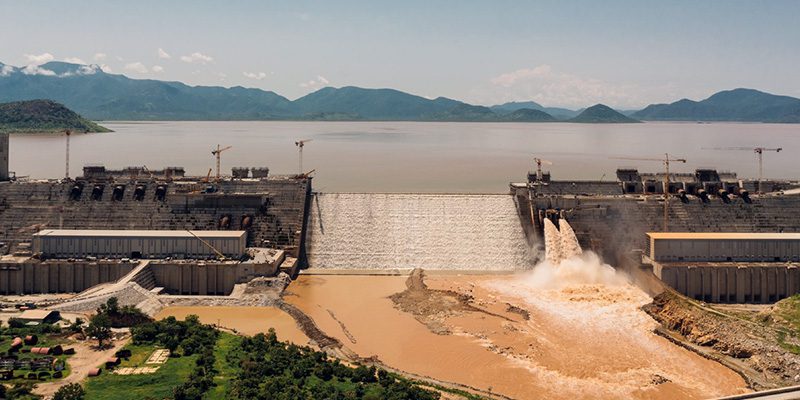Harnessing the Blue Nile: Ethiopia’s Grand Ethiopian Renaissance Dam and the Unfolding Impact on Nations Downstream

Introduction:
In the heart of East Africa, Ethiopia is undertaking a colossal endeavor that is reshaping the dynamics of the Blue Nile—the Grand Ethiopian Renaissance Dam (GERD). This monumental hydroelectric project, initiated in 2011, holds the promise of transforming Ethiopia’s energy landscape while introducing a complex set of challenges and opportunities for downstream nations. This comprehensive exploration aims to unravel the intricate tapestry of Ethiopia’s mega-dam on the Blue Nile, delving into its genesis, the technical prowess behind its construction, and the multifaceted impact it heralds for the nations situated downstream.
Historical Context: The Blue Nile as a Lifeline
The Blue Nile, one of the two main tributaries of the Nile River, has long played a pivotal role in the historical, cultural, and economic narratives of the region. Flowing from the Ethiopian Highlands through Sudan and eventually merging with the White Nile in Egypt, the Blue Nile has been a source of life, sustenance, and historical significance for the nations through which it courses.
Genesis of the Grand Ethiopian Renaissance Dam: A Vision of Progress
The idea of harnessing the Blue Nile’s potential for energy dates back decades, but it was in the 21st century that Ethiopia embarked on a visionary project to leverage the river’s power. The GERD, initiated under the leadership of the Ethiopian government, symbolizes a commitment to economic development, energy security, and regional transformation. With a planned capacity exceeding 6,000 megawatts, the dam is poised to become Africa’s largest hydropower project upon completion.
Technical Marvel: Engineering the Future
The construction of the GERD is an engineering marvel, blending traditional construction methods with cutting-edge technology. Nestled in the Benishangul-Gumuz region, the dam boasts a roller-compacted concrete structure, an expansive reservoir, and turbines designed to convert the force of the flowing river into a sustainable source of electricity. As Ethiopia harnesses the power of the Blue Nile, the technical intricacies of the dam underscore the nation’s commitment to progress and self-sufficiency.
Downstream Impact: Navigating the Waters of Diplomacy
As the Blue Nile flows downstream, the GERD introduces a new dynamic for nations situated along its path—Sudan and Egypt. The potential ramifications of altered water flow, agricultural practices, and environmental changes have sparked diplomatic negotiations and geopolitical tensions. Ethiopia, keen on realizing the benefits of the dam, engages in ongoing discussions to address concerns raised by downstream nations, navigating a delicate balance between progress and cooperation.
Economic Opportunities: Powering Ethiopia’s Ascent
One of the primary motivations behind the GERD is the promise of abundant and affordable electricity. Ethiopia envisions the dam as a catalyst for economic growth, industrialization, and enhanced energy security. The increased power generation is expected to spur investment, job creation, and technological advancement, positioning Ethiopia as a regional powerhouse.
Environmental Considerations: Balancing Progress and Preservation
While the economic benefits are substantial, the environmental impact of the GERD is a source of scrutiny. Changes in water flow, potential alterations to downstream ecosystems, and the management of sedimentation pose challenges that demand careful consideration. Ethiopia faces the task of balancing the imperatives of progress with the preservation of the Blue Nile’s natural attributes.
Geopolitical Dimensions: Negotiations and Regional Stability
The construction and filling of the GERD reservoir have become focal points in regional geopolitics. Negotiations between Ethiopia, Sudan, and Egypt involve intricate discussions on water usage, drought mitigation, and the equitable distribution of Nile waters. Ethiopia, asserting its sovereign right to harness the Blue Nile, grapples with the complexities of regional diplomacy to ensure a stable and mutually beneficial outcome.
Hydro-Diplomacy: A Path to Equitable Solutions
Hydro-diplomacy emerges as a critical component in managing the complex geopolitics surrounding the GERD. Ethiopia, Sudan, and Egypt engage in negotiations to establish a framework that ensures fair and equitable water distribution, environmental sustainability, and regional stability. The diplomatic efforts reflect the shared responsibility of nations in managing transboundary water resources for the greater good.
Global Ramifications: Lessons for Transboundary Projects
The GERD, with its global significance, offers lessons and insights for nations embarking on large-scale transboundary infrastructure projects. The international community observes closely as Ethiopia pioneers the development of a mega-dam, considering the broader implications for sustainable development, shared resources, and the evolving dynamics of regional cooperation.
The Path Forward: Collaborative Solutions for a Shared Future
As Ethiopia progresses with the GERD, the path forward requires a commitment to collaborative solutions that balance the aspirations of a nation with the collective needs of the region. Sustainable development, environmental stewardship, and diplomatic engagement stand as pillars for navigating the intricate waters of the Blue Nile. Ethiopia’s journey with the GERD underscores the interconnectedness of nations and the imperative of responsible resource management.
Conclusion: Ethiopia’s Hydrological Odyssey
In conclusion, Ethiopia’s Grand Ethiopian Renaissance Dam on the Blue Nile represents a hydrological odyssey, a journey of progress, challenges, and shared responsibilities. As the nation harnesses the power of its abundant water resources, the impact reverberates downstream, testing the bounds of diplomacy, environmental stewardship, and regional cooperation. Ethiopia’s endeavor serves as a beacon for nations seeking to navigate the complexities of large-scale infrastructure projects in an interconnected world. The unfolding story of the GERD is emblematic of the delicate dance between development and preservation, sovereignty and collaboration—a dance that shapes the future of the Blue Nile and the nations it touches.




